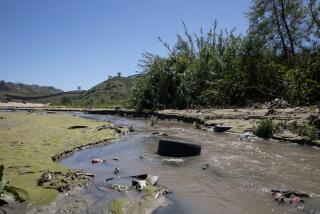Santa Monica Bay’s Effect on Health to Be Studied : Environment: People who swim in contaminated ocean areas will be interviewed. Follow-up calls will seek to determine if the surf is safe.
- Share via
A study on the health effects of swimming in Santa Monica Bay could be launched as early as this summer, after the Los Angeles City Council’s approval Tuesday of much of the funding for the ambitious effort.
Environmentalists and government scientists said the survey is needed to answer one of the region’s most nagging public health questions: Is it safe to swim in the bay?
Although no epidemiological study has been attempted, stories of surfers with skin rashes, swimmers with stomach flu and lifeguards with ear infections have become part of coastal lore.
The reports have become so pervasive among the 60 million people who visit Santa Monica Bay beaches each year that it has apparently kept many out of the water. A 1992 study found that more than half of 500 beach-goers surveyed said they did not swim, most of them because of pollution concerns.
“With this study, the public will finally know the risk and whether that changes depending on where you swim,” said Mark Gold, staff scientist for the environmental group Heal the Bay. “This is the No. 1 question everyone asks and this is the study that will finally answer the question.”
The study will include interviews with 9,000 people to determine if visitors to the beach become ill after swimming in the bay.
In a special vote, bypassing its usual committee system, the City Council unanimously approved a $300,000 payment for the $650,000 study. The vote was hurried in hopes of getting the project organized in time to begin this summer.
Officials said the prompt action by Los Angeles will help assure that other agencies contribute funding so that the study can begin in June. Two-thirds of the city’s payment will be refunded by the state, and officials hope to obtain the rest of the money or other assistance from the city of Santa Monica, a South Bay hospital district and the agencies that operate sewer systems in Los Angeles and Orange counties.
“It looks good that we will get the money. The study is absolutely essential,” said Catherine Tyrrell, director of the Santa Monica Bay Restoration Project, an alliance of government and private groups that is overseeing efforts to clean up the bay. If the project proceeds as expected, teams of student investigators directed by a UCLA biologist will interview ocean swimmers during a 16-week period this summer. The subjects of the survey will be contacted by telephone three days after they leave the beach and then a week after that to see if they become ill.
The survey will focus on swimmers at two beaches--one at the base of Chautauqua Boulevard in Pacific Palisades and the other in Santa Monica, a mile south of the Santa Monica Pier. High levels of bacteria have been measured at both locations, where storm drains spew urban runoff into the surf.
These contaminated concrete streams have become the primary concern of environmentalists, after the reduction of pollution from sewers and industry. The storm drains carry a witch’s brew of plants, pet droppings, pesticides, oil and other street wastes with health effects that have not been assessed.
The study will measure the health effects on those who swim near the drains and compare the results with a control group of swimmers who enter water that is not directly polluted by storm drains.
As many as two other beaches may be added to the study later, officials said.
At the same time swimmers are being surveyed, researchers will sample ocean water for bacteria and a variety of viruses.
The findings might be used to create better tests to assess the safety of swimming in the water. Public health and water officials generally agree that the E. coli bacteria that are now routinely measured by city and county investigators are a poor indicator of swimming safety. The organisms are too common and not necessarily associated with the transmission of diseases, said David Cohen, chief of planning and standards with the State Water Resources Board.
“We think this is a very important study because the standards we use now are very old,” Cohen said Tuesday. “This might provide some new tools to find some better testing organisms” to warn when water is not fit for human contact.
Results from the surveys could be available by the end of the year.
A second round of interviews may be conducted at beaches next winter, Cohen said. The later surveys are needed because health risks may be greatest after it rains, when the ocean is polluted with a deluge of contaminated storm water.
The county Department of Health Services recommends against swimming in Santa Monica Bay for three days after substantial rains because of contaminants. But many swimmers and surfers ignore the warnings.
“If the problems are real, we need to do something about them,” said Councilwoman Laura Chick, who sponsored the council action. “If they aren’t real, we need to start beating our drums and say, ‘Come one, come all to our beaches.’ ”
More to Read
Sign up for Essential California
The most important California stories and recommendations in your inbox every morning.
You may occasionally receive promotional content from the Los Angeles Times.











